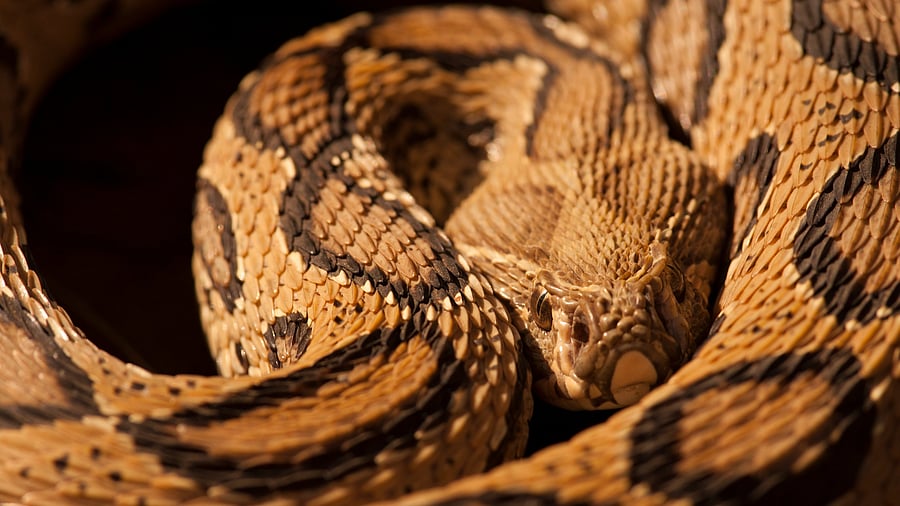
Credit: Special Arrangement
When we first dropped anchor at Navilu Kaadu over six years ago, the then caretaker often spotted a large snake skulking around the land. The sight of the slithering serpent spooked him out of his wits. Our older teen too spotted the snake, a thick ponderous reptile near our outdoor shower area — the magnificent Russell’s Viper, one of the big four venomous snakes of India.
Russell’s Vipers called Kolaku Mandala in Kannada, are ecologically useful species that play a pivotal role in preserving the balance of ecosystems they inhabit.
Without these vipers, rodent numbers can explode, decimating crops, impacting livelihoods and imperilling food security. But these snakes end up being killed regardless, for merely being seen in the vicinity of humans. They are much maligned and feared for their potent venom.
In their defense, these torpid, languorous snakes are known to be sedentary and passive when left to themselves. They are seldom quick to bite unless provoked. When threatened, they coil furiously and emit loud warning hisses.
These last three columns have inadvertently turned into a serpent series, but I couldn’t not crow about at least one of the venomous snake species flourishing among the wild grasses and glades of Navilu Kaadu.
Venomous snakes are often inaccurately labelled ‘poisonous’ snakes. The adjectives venomous and poisonous describe two distinct ways that some creatures deploy toxins for self-defence and predation.
Biologists use the term venomous to describe organisms that inject toxins when they sting or bite. Poisonous creatures, on the other hand, release toxins passively when they are eaten.
Of the big four venomous snakes of India, the Russell’s Viper (Daboia russelii) and the Indian saw-scaled viper (Echis carinatus) fold under the Viperidae snake family. The other two, the common krait (Bungarus caeruleus) and the Indian cobra or the spectacled cobra (Naja naja) belong to the Elapidae family.
The spectacled cobra and Russell’s Viper are integral to our tiny wild ecosystem at Navilu Kaadu. The former is said to prey on the latter despite the viper’s wider girth.
Russell’s Vipers are dapper ochre-hued snakes with three lines of striking, rust-brown moons outlined in black along their length. The markings serve as clever camouflage. They have distinctive triangular heads with large gold-flecked eyes, and stout midsections and grow to a length of about five feet.
They are the namesakes of Scottish herpetologist Patrick Russell, who contributed significantly to our understanding of snakes of the Indian sub-continent in the mid to late 1700s.
They are mostly nocturnal and terrestrial and inhabit the plains, farmland and scrubland. Reckless urbanisation and agricultural expansion are displacing Russell’s Vipers and their ilk from their natural habitats, compelling them to eke out a perilous living in garbage-infested human habitation, putting these vipers and humans on a collision course.
Little surprise then that the Russell’s Vipers are saddled with the unenviable reputation of causing the highest number of human snake bites in India. (Suraweera et al., 2020)
These fecund snakes produce large litters of over 40 snakelets, though some perish before they make it to adulthood. They are ovoviviparous — the eggs hatch inside the mum, who then delivers live young vipers.
They have sharp-tipped, hollow fangs, a tad over half an inch, that are superlative venom delivery contraptions — the Ferraris among serpent fangs, if you will!
How do these lethal daggers of venom fit into the serpent’s mouth? All vipers have solenoglyphous fangs that are hinged to the jaw and fold back along the upper jaw when not in use. Elapids like cobras and kraits, on the other hand, have proteroglyphous fangs that are fixed to the jaw and hence must be compact.
True to their sluggish disposition, Russell’s Vipers are ambush or sit-and-wait predators. They lurk amid grass in anticipation of doomed rodents scurrying into their lairs. Although they lack the heat-sensing organs typically present near the nostrils in pit vipers, scientists speculate that Russell’s Vipers can use heat cues to track down prey in the dark.
A study suggests that Russell’s Vipers and spectacled cobras are on the rise in Bengaluru (Kalki et al., 2021), what with a plentiful prey base propagated by indiscriminate littering. This underpins the need for two things — to honour nature’s delicate balance by holding space for wild creatures in our midst and to prioritise public sanitation and responsible garbage management in urban neighbourhoods, keeping rodents and their predators at bay.
Rooting for Nature is a monthly column on an off-kilter urban family’s trysts with nature on a natural farm.
The author chipped away at a software marketing career before shifting gears to sustainable entrepreneurship and natural farming. She posts as @ramyacoushik on Instagram. Reach her at bluejaydiaries@gmail.com